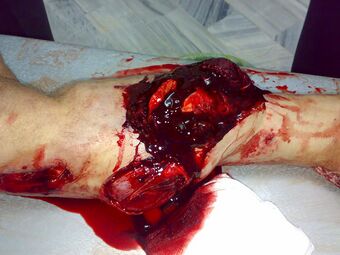Medicine:Tibia shaft fracture
| Tibia shaft fracture | |
|---|---|
 | |
| Open fracture of the shaft of the tibia. | |
| Specialty | Orthopedics |
Tibia shaft fracture is a fracture of the proximal (upper) third of the tibia (lower leg bone). Due to the location of the tibia, it is frequently injured. Thus it is the most commonly fractured long bone in the body.[1]
Signs and symptoms
Patients with tibial shaft fractures present with pain and localized swelling.[2] Due to the pain they are unable to bear weight. There may be deformity, angulation, or malroation of the leg.[2] Fractures that are open (bone exposed or breaking the skin) are common.[citation needed]
Mechanism
Since approximately one third of the tibia lies directly beneath the skin, open fractures are common compared to other long bones.[1] These open fractures are most commonly caused by high velocity trauma (e.g. motor vehicle collisions), while closed fractures most commonly occur from sports injuries or falls.[3][4] Osteoporosis can be a contributing factor.[3] Skiing and football (soccer) injuries are also common culprits.[4]
Diagnosis
Examination
Prior to realignment and splinting an assessment is performed to ensure there are no open wounds, soft-tissue contusions, or neurovascular injuries.[1]
Radiography
Anteroposterior (AP) and lateral radiographs the include the entire length of the lower leg (knee to ankle) are highly sensitive and specific for tibial shaft fractures.[4]
Classification
Two systems of fracture classification are commonly used to aid diagnosis and management of tibia shaft fractures:[citation needed]
- Oestern and Tscherne Classification
- Gustilo-Anderson Classification
Management is dependent on the determination of whether the fracture is open or closed.[citation needed]
Management
Nonoperative treatment
Nonsurgical treatment of tibia shaft fractures is now limited to closed, stable, isolated, minimally displaced fractures caused by a low-energy mechanism of injury.[1] This treatment consists of application of a long-leg cast.[5]
Operative treatment
Surgical treatment is typically indicated for high-energy trauma fractures.[1] Intramedullary nailing is a common technique, but external fixation may have equivalent outcomes.[6]
Epidemiology
Tibia shaft fractures are the most common long bone fractures. They account for approximately 4% of the fractures seen in the Medicare population.[2] Tibia shaft fractures are particularly common injuries in certain sports, such as in MMA, where a successful check against an incoming low kick (a defensive technique in which the receiver's shin is used to block the low kick) can result in the practitioner of the kick fracturing their own shin.[7][8]
References
- ↑ Jump up to: 1.0 1.1 1.2 1.3 1.4 Terry Canale, S.; Azar, Frederick M.; Beaty, James H. (2016-11-21). Campbell's operative orthopaedics. Azar, Frederick M.,, Canale, S. T. (S. Terry),, Beaty, James H.,, Preceded by: Campbell, Willis C. (Willis Cohoon), 1880-1941. (Thirteenth ed.). Philadelphia, PA. ISBN 9780323374620. OCLC 962333989.
- ↑ Jump up to: 2.0 2.1 2.2 "Tibia Shaft Fractures - Trauma - Orthobullets.com" (in en). https://www.orthobullets.com/trauma/1045/tibia-shaft-fractures.
- ↑ Jump up to: 3.0 3.1 Grütter, R.; Cordey, J.; Bühler, M.; Johner, R.; Regazzoni, P. (September 2000). "The epidemiology of diaphyseal fractures of the tibia". Injury 31 (Suppl 3): C64–67. doi:10.1016/s0020-1383(00)80035-2. ISSN 0020-1383. PMID 11052384.
- ↑ Jump up to: 4.0 4.1 4.2 "Tibial shaft fractures in adults". https://www.uptodate.com/contents/tibial-shaft-fractures-in-adults?source=search_result&search=tibia%20shaft%20fracture&selectedTitle=2~150.
- ↑ Busse, Jason W.; Morton, Emily; Lacchetti, Christina; Guyatt, Gordon H.; Bhandari, Mohit (October 2008). "Current management of tibial shaft fractures: a survey of 450 Canadian orthopedic trauma surgeons". Acta Orthopaedica 79 (5): 689–694. doi:10.1080/17453670810016722. ISSN 1745-3682. PMID 18839377.
- ↑ Littenberg, B.; Weinstein, L. P.; McCarren, M.; Mead, T.; Swiontkowski, M. F.; Rudicel, S. A.; Heck, D. (February 1998). "Closed fractures of the tibial shaft. A meta-analysis of three methods of treatment". The Journal of Bone and Joint Surgery. American Volume 80 (2): 174–183. doi:10.2106/00004623-199802000-00004. ISSN 0021-9355. PMID 9486723.
- ↑ "Are Broken Bones Common In MMA? | MMA Hive" (in en-us). 2021-05-19. https://www.mmahive.com/are-broken-bones-common-in-mma/.
- ↑ Apampa, Bobola (2021-04-28). "MMA Injuries: Tibial Fractures" (in en). https://www.officialax3.com/post/mma-injuries-tibial-fractures.
External links
 |

